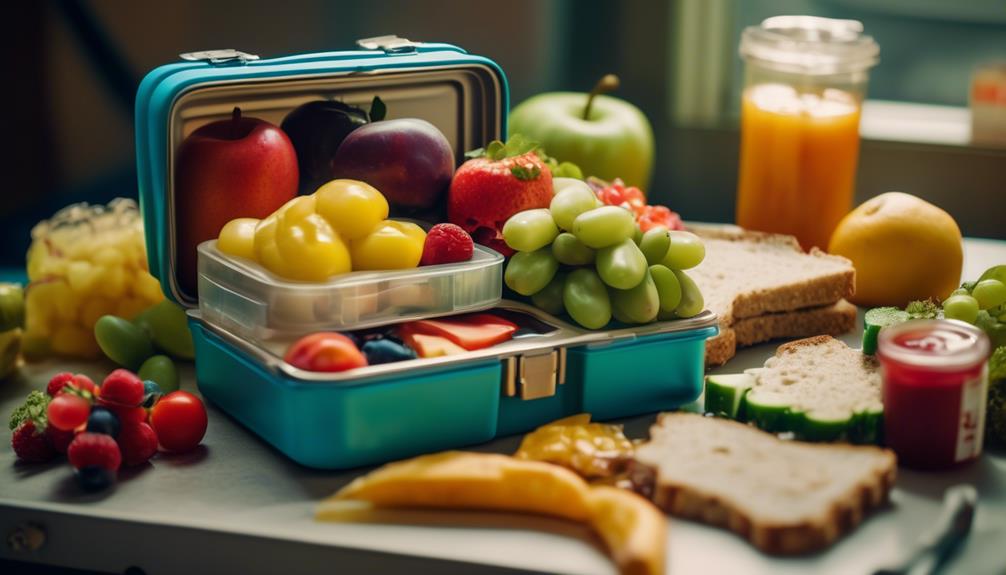How to Resist Cutting Corners With Prepackaged School Lunches

Creating healthy and balanced school lunches without relying on prepackaged options requires some planning and creativity. Here are some tips and strategies to help you:
- Plan ahead: Take some time each week to plan your child's lunches. Consider the food groups and aim to include a variety of fruits, vegetables, whole grains, and lean proteins.
- Get your child involved: Encourage your child to help choose and prepare their lunches. This can increase their interest in healthy foods and give them a sense of ownership over their meals.
- Make use of leftovers: Utilize leftovers from dinner to create nutritious lunches. For example, leftover grilled chicken can be used in a wrap or salad, and cooked vegetables can be added to a pasta dish.
- Pack in the fruits and veggies: Include a variety of fresh fruits and vegetables in your child's lunch. Cut them into fun shapes or pack them alongside a dip to make them more appealing.
- Opt for whole grains: Choose whole grain bread, wraps, or pasta for added fiber and nutrients. These options can keep your child feeling full and satisfied throughout the day.
- Include a source of protein: Pack a source of protein such as lean meats, beans, or nuts. This can help keep your child energized and focused throughout the school day.
- Choose healthier snacks: Instead of relying on prepackaged snacks, opt for homemade alternatives such as trail mix, yogurt with fruit, or homemade granola bars.
- Don't forget hydration: Encourage your child to drink plenty of water throughout the day. Consider packing a reusable water bottle to help them stay hydrated.
Remember, creating healthy and balanced school lunches takes time and effort, but it is worth it for your child's overall well-being. By planning ahead and incorporating a variety of nutritious foods, you can ensure your child is getting the fuel they need for a successful school day.
Importance of Homemade Meals
When it comes to providing nutritious meals for your children, nothing beats the importance of homemade meals. Homemade meals are typically healthier and more nutritious compared to prepackaged options. Parents have more control over the ingredients and portion sizes when preparing homemade meals for their kids. This means you can ensure that your children are getting the right balance of nutrients they need to grow and thrive.
Involving your children in the meal preparation process can also encourage them to develop healthy eating habits and make better food choices. They'll learn about different types of foods and how to prepare them, which can set the foundation for a lifetime of healthy eating.
Additionally, homemade meals allow for greater variety, ensuring that your kids have access to a wider range of nutrients and flavors. By making their lunches at home, you can include a variety of fruits, vegetables, whole grains, and proteins, which are all essential for their overall health and well-being.
Eating homemade meals as a family can also promote bonding and create positive associations with healthy eating. So, take the time to make packed lunches for your kids, as it's a small investment that can have long-lasting benefits for their health.
Nutritional Benefits of Fresh Ingredients
When it comes to your child's school lunch, opting for fresh ingredients over processed ones can offer numerous health benefits.
Fresh ingredients are generally higher in essential nutrients like vitamins, minerals, and antioxidants, which promote overall well-being and support proper growth and development.
Additionally, fresh ingredients are less likely to contain additives, preservatives, and unhealthy fats, making them a healthier choice for your child's diet.
Fresh Vs. Processed
Fresh ingredients offer numerous nutritional benefits over processed options, making them a healthier choice for children's school lunches. Compared to processed foods, fresh ingredients retain more nutrients and are often lower in sodium and additives. They provide a wider array of vitamins, minerals, and antioxidants crucial for kids' growth and development. Processed foods, on the other hand, often contain added sugars and unhealthy fats. By choosing fresh ingredients, you can provide natural sources of energy and essential nutrients to support a balanced diet and contribute to better overall health, immune function, and cognitive performance in children. Additionally, opting for fresh ingredients encourages diverse and colorful meal options, promoting a more varied and nutrient-rich diet for your kids.
| Fresh Ingredients | Processed Foods |
|---|---|
| Retain more nutrients | Higher in sodium and additives |
| Provide wide array of vitamins, minerals, and antioxidants | Contain added sugars and unhealthy fats |
| Natural sources of energy and essential nutrients | Less nutritious and less beneficial for health |
Health Benefits of Freshness
To maximize the nutritional benefits of school lunches, incorporating fresh ingredients is essential. Here are the health benefits of freshness that your child can enjoy:
- Retained Nutritional Value: Fresh ingredients retain more of their nutrients compared to prepackaged or processed foods. This means that your child gets a higher concentration of essential vitamins, minerals, and antioxidants that contribute to their overall health and well-being.
- Appetizing Flavors and Textures: The natural flavors and textures of fresh ingredients can make school lunches more appealing to children. By incorporating fresh fruits and vegetables, such as apple slices, you can entice your child to eat healthier and enjoy their meals.
- Balanced and Nutritious: Fresh ingredients are free from additives, preservatives, and excessive sodium. By choosing whole foods during grocery shopping, you can promote a more balanced and nutritious diet for your child, supporting their growth and development.
- Variety of Flavors and Nutrients: Incorporating fresh, seasonal produce in school lunches exposes children to a variety of flavors and nutrients. This supports their developing palates and nutritional needs, helping them establish a love for wholesome foods.
For more tips and ideas on how to make your child's food more nutritious and enjoyable, feel free to reach out to us at [email address].
Time-Saving Meal Planning Tips
For efficient and time-saving meal planning, consider prepping a variety of fruits and veggies at the beginning of the week. This will make it easier to pack healthy snacks and incorporate them into your lunch packing routine. By pre-cutting and portioning them out into individual containers, you can easily grab them throughout the week and avoid the temptation of reaching for pre-packaged foods.
Another time-saving tip is to make use of leftovers. Instead of letting them go to waste, portion them out into containers ahead of time. This way, you can simply grab a container from the fridge and have a ready-made lunch the next day. Additionally, consider batch preparation of items like homemade yogurt or soup. This will save you time during the week and ensure that you have a nutritious lunch option readily available.
To maximize your efficiency, try to prepare items for lunch simultaneously with serving meals. For example, while you're making dinner, pack some leftovers or prep veggies for the next day's lunch. This will help you save time and keep your food cold until lunchtime.
Lastly, don't forget about freezer-friendly options. Frozen fruits and vegetables can be a convenient and nutritious addition to your lunch packing routine. They stay fresh for longer and can easily be added to salads, smoothies, or as a side to your main dish.
Creative and Healthy Lunch Ideas
Looking for fun and nutritious lunch ideas? Get your kids involved in choosing and packing their own lunches to promote healthy eating habits.
Consider using bento boxes with different compartments to create a balanced meal and encourage their participation.
Planning meals in advance can help ensure consistent, nutritious options and reduce waste.
Fun and Nutritious Recipes
Get creative and make lunchtime fun and nutritious with these delicious and visually appealing recipes. Here are some ideas to try:
- Bento Boxes: Use bento boxes with different compartments to pack a balanced meal. Include a mix of fruits, vegetables, whole grains, and protein sources. This not only makes the meal visually appealing but also ensures your child gets a variety of nutrients.
- Involve Kids in Meal Preparation: Let your children choose their food items and pack their lunches. When they have a say in what they eat, they are more likely to enjoy and finish their meals.
- Use Leftover Pasta: Transform leftover pasta into a tasty pasta salad. Mix it with some veggies, protein like chicken or beans, and a light dressing. It's a great way to reduce food waste and provide a filling lunch.
- Snack Options: Incorporate healthy snacks like yogurt pouches, cheese sticks, and cherry tomatoes. These options are convenient, nutritious, and appealing to kids.
Time-Saving Meal Prep
When it comes to time-saving meal prep for creative and healthy lunch ideas, there are several strategies you can implement to streamline the process and ensure your child enjoys a nutritious meal at school.
One option is to utilize bento boxes with different compartments to pack a balanced meal. These boxes allow you to portion out fruits, vegetables, proteins, and grains, making it easy to create a well-rounded lunch.
Another time-saving tip is to involve your children in meal planning and preparation. Not only does this promote healthy eating habits, but it also saves you time in the kitchen.
Additionally, planning and preparing lunches in advance can save you precious minutes during busy mornings. Consider creating sandwich kits by assembling all the ingredients separately to prevent soggy sandwiches.
Lastly, for a quick and nutritious lunch alternative, try to avoid using plastic baggies and instead opt for small containers to pack snacks like granola bars or leftover pancakes.
Engaging Kids in Lunch Preparation
Engage your kids in lunch preparation to foster their creativity, independence, and healthy eating habits. By involving them in the process, you not only teach them valuable life skills but also ensure that they've nutritious meals to enjoy at school.
Here are four simple ways to engage your kids in lunch preparation:
- Make sure your kids know the importance of packing a lunch:
Explain to them why it's important to eat a balanced meal and how it can help them stay focused and energized throughout the day.
- Take them grocery shopping:
Involve your kids in the grocery shopping process. Let them choose different foods they want to include in their lunches. This won't only give them a sense of ownership but also expose them to new and healthy options.
- Set up a lunch packing station at home:
Create a designated area where your kids can pack their lunches. Provide them with containers, sandwich bags, and other necessary supplies. This will encourage them to take responsibility for their own meals.
- Encourage creativity:
Encourage your kids to think outside the box when it comes to lunch ideas. Let them experiment with different combinations of fruits, vegetables, and proteins. This won't only make their lunches more exciting but also help them develop a taste for a variety of foods.
Avoiding Unhealthy Prepackaged Options
To ensure that your child's school lunches are healthy and nutritious, it's important to prioritize whole, unprocessed foods over prepackaged options. By doing so, you can avoid unhealthy additives, excess sugar, and sodium that are often found in these prepackaged foods. Instead, try incorporating super healthy food items into your child's lunch box.
Start by including plenty of fresh fruits and vegetables. These provide essential vitamins, minerals, and fiber that support your child's growth and development. Opt for lean protein sources, such as grilled chicken or turkey, to provide the necessary nutrients for their active lifestyle.
When selecting prepackaged options, read labels carefully and be mindful of hidden ingredients. Look for transparency in food choices to promote better health. If possible, get creative and make homemade versions of these snacks. For example, you can make your own granola bars or trail mix, allowing you to control the ingredients and tailor them to your child's preferences.
It's also important to emphasize the importance of balanced meals and educate your child about making healthy choices. Empower them to select and pack their own lunches with nutritious options. By doing so, you can ensure that your child is getting a healthy meal that will fuel them throughout the day.
Budget-Friendly Alternatives
Consider these budget-friendly alternatives to ensure that your child's school lunches are both nutritious and cost-effective.
- Opt for seasonal fruits and vegetables: Seasonal produce tends to be more affordable and readily available. Not only will this help you save money, but it will also provide your child with a variety of vitamins and minerals to support their growth and development.
- Choose store-brand or generic items: Many store-brand or generic products are just as nutritious as their more expensive counterparts. By opting for these options, you can significantly reduce your grocery bill without sacrificing quality.
- Utilize dry goods: Beans, rice, and pasta are affordable and versatile ingredients that can serve as a foundation for many different meals. They're also shelf-stable and can be bought in bulk, making them a great option for the entire school year.
- Plan meals in bulk: Take the time to plan meals that can be made in large quantities and used for multiple lunches throughout the week. This not only saves money but also saves much time in the morning when packing the lunch box.
Frequently Asked Questions
Is It Cheaper to Pack or Buy School Lunch?
Packing your own school lunch is cheaper than buying prepackaged ones. You can save money by buying ingredients in bulk and making healthy, homemade meals. Plus, you have control over the nutritional value and portion sizes.
How Do You Pack School Lunches the Night Before?
To pack school lunches the night before, save time by prepping ingredients in advance. Choose healthy options like fruits and veggies, get creative with presentation, and consider nut-free alternatives. Opt for budget-friendly ideas like using leftovers and involving picky eaters in the process.
How Do You Pack Lunch Without It Getting Soggy?
To avoid soggy lunches, try these lunchbox hacks: use separate containers for wet and dry ingredients, pack sandwiches with condiments on the side, and opt for creative sandwich ideas like wraps or pinwheels.
What Are the Disadvantages of Packing Lunch?
Packing lunch can have health implications due to high sodium, added sugars, and processed foods. It may lack variety and be time-consuming. There's a risk of food waste and difficulty in keeping food fresh. Socially, children may feel limited.











